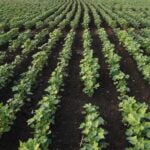Blog Last Updated on 2 years ago by Siliveru Rakesh
Karnataka, a state located in the southern part of India, is home to diverse soil types that have been formed due to various geological and climatic conditions. The five major categories of soils present in Karnataka are red soil, laterite soil, black soil, coastal sandy soil, and alluvial soil. Each type has unique characteristics that make it suitable for specific agricultural practices.
Understanding the properties and distribution of Types Of Soils In Karnataka is crucial for farmers and researchers alike as it can aid in selecting appropriate crops and cultivation techniques. This article aims to provide an overview of the major types of soils found in Karnataka along with their features, formation process, distribution, benefits, and limitations.
Read our latest blog post about: Aditya Hrudayam in Telugu
By gaining knowledge about the various soil types present across this region, readers can develop a deeper understanding of how environmental factors impact agricultural productivity and sustainability in Karnataka.
Key Takeaways
- Red soil, laterite soil, black soil, coastal sandy soil, and alluvial soil are the major categories of soil in Karnataka.
- Different soil types have unique properties and require specific management practices for optimal crop cultivation.
- Sustainable agriculture practices such as crop rotation, adding organic matter, and mulching are essential for maintaining healthy soils.
- Climate change poses a significant threat to the future viability of coastal sandy soil in Karnataka, and soil degradation can result in decreased productivity levels.
Learn more about Festivals Of Karnataka
Red Soil – Characteristics and Distribution in Karnataka

The red soil, known for its high iron oxide content and well-drained properties, is widely distributed throughout Karnataka’s agricultural regions, providing a fertile ground for farmers to cultivate their crops. The mineral composition of the soil greatly impacts crop yield in these regions.
Red soil has less organic matter and nutrients compared to other soils, making it imperative for farmers to use fertilizers and implement conservation practices such as mulching and crop rotation to maintain soil fertility. Despite being highly productive, red soil is susceptible to erosion due to its loose structure.
Hence, farmers in Karnataka have begun implementing conservation practices like contour plowing, strip cropping, and terracing. These practices help prevent water runoff during heavy rainfall events and preserve topsoil from being washed away.
With proper care and management of the red soil in Karnataka’s agricultural lands through good farming practices such as nutrient management techniques that minimize loss or degradation of vital elements necessary for plant growth, this type of soil can continue providing a rich source of nutrients for crops.
Laterite soil formation and properties in Karnataka can be attributed to factors such as weathering processes that occur over millions of years under tropical conditions. This type of soil is typically found in areas with high rainfall rates due to its porous nature which allows water infiltration into deeper layers below the surface.
Laterite Soil – Formation and Properties in Karnataka

Formed through the interplay of weathering and erosion, laterite soil in Karnataka is known for its characteristic red color and high concentration of iron oxide. This soil type is commonly found in the hilly regions of the state, especially in areas with heavy rainfall and high temperatures.
Some key features of laterite soil include a porous structure that allows for good drainage and air circulation, which can be beneficial for certain crops. Additionally, this soil type tends to have lower acidity levels compared to other types of soils in Karnataka. However, one major drawback is that it has low fertility due to its low mineral content.
The formation process of laterite soil involves the leaching out of minerals like calcium and magnesium from rocks over long periods of time. As these minerals are removed by water or acidic substances, iron oxides begin to accumulate in their place. The resulting reddish-brown colored soil is rich in iron but poor in nutrients like nitrogen and phosphorus.
Moving on to black soil – features and agricultural importance in Karnataka – this type of soil is characterized by its dark coloration due to high amounts of organic matter. It is also known for its ability to retain moisture well, making it an ideal choice for cultivating crops during dry seasons.
Black Soil – Features and Agricultural Importance in Karnataka

Black soil is highly valued in agriculture due to its unique properties that make it a popular choice for crop cultivation during dry seasons in Karnataka. This type of soil is characterized by its rich, dark color and high clay content, which enable it to retain moisture better than other soils. Additionally, black soil has a high nutrient-holding capacity that promotes agricultural productivity.
To maximize the benefits of black soil, farmers employ various soil management techniques such as mulching, crop rotation, and intercropping. Mulching involves covering the surface of the soil with plant residues to reduce water evaporation and enhance nutrient retention. Crop rotation entails planting different crops on the same land seasonally to prevent depletion of nutrients while intercropping involves planting two or more crops on the same piece of land simultaneously.
In conclusion, black soil is an important resource for agricultural production in Karnataka due to its ability to retain moisture and hold nutrients. With proper soil management techniques such as mulching, crop rotation and intercropping, farmers can optimize their yields and improve their livelihoods.
Learn more about Folk Dance Of Karnataka
Next up we will discuss coastal sandy soils – their composition and uses in Karnataka.
Coastal Sandy Soil – Composition and Uses in Karnataka

One cannot help but marvel at the uniqueness of coastal sandy soil and its potential uses in agriculture, as it presents both opportunities and challenges for farmers.
Coastal sandy soil is composed mainly of sand particles, which are loosely packed together and have poor water retention capacity. As a result, this type of soil requires frequent irrigation to sustain crop growth.
Despite its limitations, coastal sandy soil has several advantages that make it suitable for certain crops like coconut, cashew nuts, and betel nut. Additionally, this type of soil is useful in construction due to its easy excavation properties.
However, climate change poses a significant threat to the future viability of coastal sandy soil in Karnataka as sea level rise can cause increased salinity levels that negatively impact crop growth.
As such, farmers need to be aware of these challenges when utilizing coastal sandy soil for agricultural purposes. They must also take proactive steps to mitigate the effects of climate change by adopting sustainable farming practices that promote conservation and enhance the overall fertility of the land.
In contrast with coastal sandy soils’ vulnerability to rising sea levels, alluvial soils formed by river deposits offer unique benefits for agriculture in Karnataka that will be explored next.
Alluvial Soil – Formation and Benefits in Karnataka

Alluvial soil, a result of the deposition of sediment carried by rivers, offers numerous benefits for agriculture in Karnataka. This type of soil is formed when flowing water erodes rocks and minerals from upstream areas and deposits them downstream. As a result, alluvial soil is rich in nutrients such as nitrogen, phosphorus, and potassium, making it highly fertile.
One benefit of alluvial soil is its ability to support high agricultural productivity. Farmers in Karnataka have been able to grow various crops such as rice, wheat, sugarcane and cotton due to the fertility of this type of soil. The agricultural output has been boosted by the availability of essential nutrients that are vital for plant growth.
Furthermore, alluvial soils allow for easy absorption and retention of water due to their porous nature. This feature makes irrigation easier and efficient since plants can absorb water with ease. Additionally, the land does not easily become waterlogged; thus minimizing crop damage caused by excessive moisture levels during rainy seasons.
In summary, alluvial soils provide an excellent foundation for agriculture in Karnataka through their formation process which results from river sediments deposition. They exhibit high nutrient content that enhances agricultural productivity by supporting diverse crops like rice and sugarcane while also allowing for efficient irrigation practices.
The next section will compare different types of soils found in Karnataka with their pros and cons for farming purposes.
Comparison of Soil Types in Karnataka – Pros and Cons for Farming
When considering the diverse range of soil compositions present in Karnataka, it is important to weigh the advantages and disadvantages each offers for agricultural purposes. The state is home to six main types of soils, including red, lateritic, alluvial, black, sandy and rocky soils. Each type has its unique characteristics that can either be advantageous or disadvantageous when it comes to farming.
Red soil is one of the most prominent soil types in Karnataka and is known for its fertility levels. It contains a high concentration of iron oxide which gives the soil its characteristic red color. However, this type of soil tends to have low water-holding capacity which can be problematic during long dry spells.
Black soil is another type that can be found throughout Karnataka’s northern regions. It has excellent water-retention capability but may become compacted during heavy rainfall leading to reduced crop yields.
The impact of climate change on soil quality in Karnataka cannot be ignored as it may lead to changes in composition and degradation over time resulting in decreased productivity levels. Soil fertility management practices such as crop rotation and adding organic matter are essential ways farmers can ensure sustainable agriculture practices while maintaining healthy soils across the different types present in Karnataka.
Learn more about Folk Dance Of Maharashtra
Frequently Asked Questions
1. What is the pH level of each type of soil in Karnataka?
Soil acidity and nutrient composition vary across different soil types in Karnataka. However, the specific pH levels of each type are not readily available without further research. Further analysis would be necessary to determine the exact pH levels of each soil type in Karnataka.
2. How do these soil types affect the water quality in Karnataka?
The soil types in Karnataka have varying impacts on agriculture and water quality. Contamination caused by excess use of fertilizers and pesticides can harm the environment, affecting the health of flora, fauna, and humans. Proper management practices are necessary to ensure sustainable land use.
3. Which crops are most suitable for each type of soil in Karnataka?
Crop rotation is key to maintaining soil fertility in Karnataka. Crops such as paddy, ragi, and sugarcane thrive in black soil while red soil supports crops like groundnut, cotton, and chillies. Clay soils are suitable for vegetables and fruits.
4. What are the main environmental concerns related to the use and management of these soil types in Karnataka?
The use and management of soils in Karnataka can have significant environmental impacts. Sustainable practices, such as conservation tillage and crop rotation, can help mitigate soil erosion, nutrient depletion, and pesticide contamination.
5. How does the government regulate the use of these soil types in agriculture and construction in Karnataka?
Like a conductor leading an orchestra, the government of Karnataka has implemented policies and land use planning to regulate the use of soil in agriculture and construction. These measures are based on technical data and aim for sustainable management.
Conclusion
In conclusion, the different soil types in Karnataka offer a diverse range of benefits and challenges to farmers in the region.
The red soils are rich in iron and aluminum, making them ideal for horticulture crops but limited for cereal production.
Laterite soils are high in clay content and prone to erosion, making them difficult to work with but suitable for plantation crops like tea and coffee.
Black soils have excellent water retention properties and provide fertile ground for cotton cultivation.
Coastal sandy soils are low in nutrients but drain well, making them suitable for horticulture crops such as mangoes and coconuts.
Alluvial soils are formed from sediment deposits along river banks, offering some of the most fertile grounds for rice cultivation in the state.
In comparison, each soil type has its pros and cons when it comes to agriculture; farmers must carefully consider their options when selecting which crop to cultivate on their land.
Overall, Karnataka’s diverse range of soil types offers both opportunities and challenges for farmers looking to maximize their yields.
With careful planning and management practices that take into account a farm’s unique soil quality, farmers can ensure they make the most of this resource-rich state.
By understanding the characteristics of each soil type within Karnataka’s borders – whether through research or consultation with agricultural experts – farmers can select appropriate crops that will thrive in these conditions while minimizing risks associated with poor yields due to unsuitable growing environments.
Learn more about Types Of Soils In Goa
- Sri Lalitha Ashtottara Shatanamavali in Telugu – శ్రీ లలితాష్టోత్తరశతనామావళిః - April 11, 2024
- Sri Durga Kavacham in Telugu – శ్రీ దుర్గా దేవి కవచం - April 10, 2024
- Shivananda Lahari in Telugu – శివానందలహరీ - April 9, 2024


